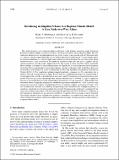| dc.contributor.author | Marcella, Marc Pace | |
| dc.contributor.author | Eltahir, Elfatih A. B. | |
| dc.date.accessioned | 2015-03-03T17:03:13Z | |
| dc.date.available | 2015-03-03T17:03:13Z | |
| dc.date.issued | 2014-11 | |
| dc.date.submitted | 2013-07 | |
| dc.identifier.issn | 0894-8755 | |
| dc.identifier.issn | 1520-0442 | |
| dc.identifier.uri | http://hdl.handle.net/1721.1/95749 | |
| dc.description.abstract | This article presents a new irrigation scheme and biome to the dynamic vegetation model, Integrated Biosphere Simulator (IBIS), coupled to version 3 of the Regional Climate Model (RegCM3-IBIS). The new land cover allows for only the plant functional type (crop) to exist in an irrigated grid cell. Irrigation water (i.e., negative runoff) is applied until the soil root zone reaches relative field capacity. The new scheme allows for irrigation scheduling (i.e., when to apply water) and for the user to determine the crop to be grown. Initial simulations show a large sensitivity of the scheme to soil texture types, how the water is applied, and the climatic conditions over the region. Application of the new scheme is tested over West Africa, specifically Mali and Niger, to simulate the potential irrigation of the Niger River. A realistic representation of irrigation of the Niger River is performed by constraining the land irrigated by the annual flow of the Niger River and the amount of arable land in the region as reported by the Food and Agriculture Organization of the United Nations (FAO). A 30-yr simulation including irrigated cropland is compared to a 30-yr simulation that is identical but with no irrigation of the Niger. Results indicate a significant greening of the irrigated land as evapotranspiration over the crop fields largely increases—mostly via increases in transpiration from plant growth. The increase in the evapotranspiration, or latent heat flux (by 65–150 W m[superscript −2]), causes a significant decrease in the sensible heat flux while surface temperatures cool on average by nearly 5°C. This cooling is felt downwind, where average daily temperatures outside the irrigation are reduced by 0.5°–1.0°C. Likewise, large increases in 2-m specific humidity are experienced across the irrigated cropland (on the order of 5 g kg[superscript −1]) but also extend farther north and east, reflecting the prevailing surface southwesterlies. Changes (decreases) in rainfall are found only over the irrigated lands of west Mali. The decrease in rainfall can be explained by the large surface cooling and collapse of the boundary layer (by approximately 500 m). Both lead to a reduction in the triggering of convection as the convective inhibition, or negative buoyant energy, is never breached. Nevertheless, the new scheme and land cover allows for a novel line of research that can accurately reflect the effects of irrigation on climate and the surrounding environment using a dynamic vegetation model coupled to a regional climate model. | en_US |
| dc.description.sponsorship | Kuwait Foundation for the Advancement of Sciences | en_US |
| dc.language.iso | en_US | |
| dc.publisher | American Meteorological Society | en_US |
| dc.relation.isversionof | http://dx.doi.org/10.1175/jcli-d-13-00116.1 | en_US |
| dc.rights | Article is made available in accordance with the publisher's policy and may be subject to US copyright law. Please refer to the publisher's site for terms of use. | en_US |
| dc.source | American Meteorological Society | en_US |
| dc.title | Introducing an Irrigation Scheme to a Regional Climate Model: A Case Study over West Africa | en_US |
| dc.type | Article | en_US |
| dc.identifier.citation | Marcella, Marc P., and Elfatih A. B. Eltahir. “Introducing an Irrigation Scheme to a Regional Climate Model: A Case Study over West Africa.” J. Climate 27, no. 15 (August 2014): 5708–5723. © 2014 American Meteorological Society | en_US |
| dc.contributor.department | Massachusetts Institute of Technology. Department of Civil and Environmental Engineering | en_US |
| dc.contributor.mitauthor | Eltahir, Elfatih A. B. | en_US |
| dc.contributor.mitauthor | Marcella, Marc Pace | en_US |
| dc.relation.journal | Journal of Climate | en_US |
| dc.eprint.version | Final published version | en_US |
| dc.type.uri | http://purl.org/eprint/type/JournalArticle | en_US |
| eprint.status | http://purl.org/eprint/status/PeerReviewed | en_US |
| dspace.orderedauthors | Marcella, Marc P.; Eltahir, Elfatih A. B. | en_US |
| dspace.mitauthor.error | true | |
| mit.license | PUBLISHER_POLICY | en_US |
| mit.metadata.status | Complete | |
